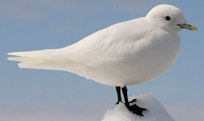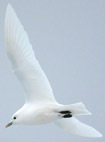Mercury threat to Arctic wildlife
9 April 2015
Alarm bells are ringing for Arctic wildlife with the discovery that mercury levels in the feathers of ivory gulls have increased almost 50-fold.

University of Saskatchewan biologists studied the feathers of museum specimens spanning a 130-year period. Lead researcher Dr Alex Bond told BBC News, “We’re concerned because the mercury’s going up but their diet hasn’t changed over the 130 years we’ve studied. It’s gone up 45 times, which is twice the average for an animal species in the Arctic.”
Scientists believe the increase in mercury pollutants could partially explain the rapid decrease in population. Ivory gull populations in Canada have decreased by more than 80 per cent since the 1980s, leading to them being officially recognised as endangered in Canada. Numbers of the birds are also falling elsewhere — the International Union for Conservation of Nature has classified the gull as “Near Threatened”.

Mercury pollution is expected to continue to rise particularly at high latitudes due to increasing emissions and global change.
“A reduction in atmospheric mercury would be key — this is probably where much of it is coming from — and that would come by burning less coal,” said Dr Bond.
The biologists say that the ivory gull acts as a “mercury barometer” for contamination of Arctic animals.
Rod Downie, Polar Programme Manager of the World Wildlife Fund – United Kingdom, commented, “This is further clear evidence of the global and circumpolar impacts of human activity on Arctic wildlife, which is already stressed by the most pronounced climate change on Earth.”
http://populationmatters.org/2015/blog/mercury-threat-to-arctic-wildlife/